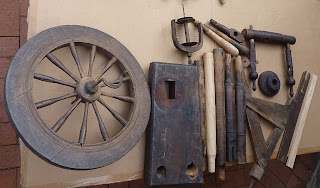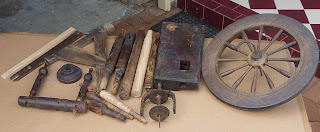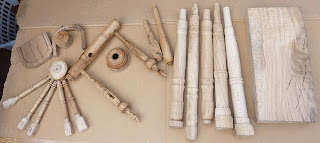
 The Old
The Old I can at last feel some work has been achieved in the repair and restoration of the 200 year old
Hebridean Spinning wheel. It had been shelved a few times, while other things took precedent. There is still work yet to be done mostly small but time consuming repairs to patch up areas for it to become a working wheel again. Also to keep it looking its age, not like its just had a make over and rebuilt.
New parts made are, one leg, one adjuster knob/handle. The old one has been repaired drilled and dowel inserted to strengthen but the thread is so worn that it won't pull back. So a new one was made. The connecting piece for the treadle.
Repairs have been done to a Maiden tower, rejoining one of the lower sections using the dowelling method. The Maiden
support block which had split was soaked in a soapy water solution for about an hour a hose clamp fitted for a period. It closed the gap from 6mm to 2mm, epoxy was used to glue and secure again using the hose clamp until dry. Drilling out the remains of the broken leg from the base.
Repair the broken wheel carrier upright, a small dowel and epoxy. A piece yet has to be fitted to both of these as years of ware has made a big impression into the wood where the axle has run.
Seen here are the riser block, the new leg, the repaired wheel carrier and the adjuster block. The adjuster block was made as a spare as the thread had to cut on the new adjuster knob and we were unsure if both would mate. The new adjuster block will now be used on Sue's copy of the Hebridean wheel.
 |
| Adjuster Block |
 |
| Mother-of-All Riser Block |
 |
| Left - The 3 legs. Right - The wheel carriers | |
 |
| The broken wheel carrier |


The footman and treadle is made of Cedar and has been repaired a few times as any cottage worker of the day would have done simple but effective. I will decide as i go if it should be replaced or repaired.
The New
 |
| Nova 3000 lathe |
 |
| A new leg |
I was fortunate enough to acquire a 2nd hand Nova 3000 lathe which I was able to turn the larger parts on such as the legs and wheel carriers for the old and new spinning wheel. This was a slow process as due to the size of my workshop/garage, the lathe could not be brought home. It is housed at the Ornamental Turners club at Llandilo some 45ks away. This meant that limited time only on a club day at the lathe to produce 3 new legs, 2 new wheel carriers etc.
Seen here is one of the legs on the Nova I had turned I wanted to do a fancier type leg compared to the original design this is just a simple coves, beads and tappers


The old wheel and all its parts along with what has been made so far of the new wheel. Shown of the new wheel from right to left :- The base, Wheel carriers, 3 legs, adjuster knob and block, riser block, Maiden and its towers/flyer carriers. The hub and 5 spokes (7 more yet to make) a roughed out flyer and two of the pulleys.
The base has yet to be worked, holes drilled, adjuster block slide hole cut and drilled. A tapper on the underside. Adjuster parts to be drilled and threaded with a more common thread type.
Metal axle forged for the main wheel and a machined axle for the Maiden made.
The pieces which are darker have been given a coat of
Woodwipe which is available through
Trend Timbers , a liberal smear after sanding of Lanolin and cloth buffed a further finish will be applied.

The spokes also had a make over I created a profile after doing a rough test run and getting approval from Sue.

The Maiden towers were sanded back after having been aged to suit fitting to the old wheel (see above Old Wheel), should the repairs not have taken. It has brought out some interesting colour and effect.

Sue asked if the new wheel could be left its golden colour after showing her how it would look it won her approval again. It will darken over time.
The spokes laid out around the hub, the wheel carriers and the 3 legs all yet to be completed, getting the shapes sizes, filling cracks etc is taking time. Even though the Oak has been down for over 5 years after being cut there is still movement also after rough turning.
 We have a Scheppach Decoflex scroll saw, after using standard pinned blades for most simple type work, nothing fancy. We bought better quality finer unpinned blades through Helen Harris. PO Box 1384 Murray Bridge SA 5253 Ph: 08 8531 3440. The scroll saw was purchased through Cumberland Wood Workers club when I was a member supplied by Hare & Forbes almost 2 years ago . It's has done some work of sorts, trimming material to small for the bandsaw such as pen blank ends.
We have a Scheppach Decoflex scroll saw, after using standard pinned blades for most simple type work, nothing fancy. We bought better quality finer unpinned blades through Helen Harris. PO Box 1384 Murray Bridge SA 5253 Ph: 08 8531 3440. The scroll saw was purchased through Cumberland Wood Workers club when I was a member supplied by Hare & Forbes almost 2 years ago . It's has done some work of sorts, trimming material to small for the bandsaw such as pen blank ends.
































